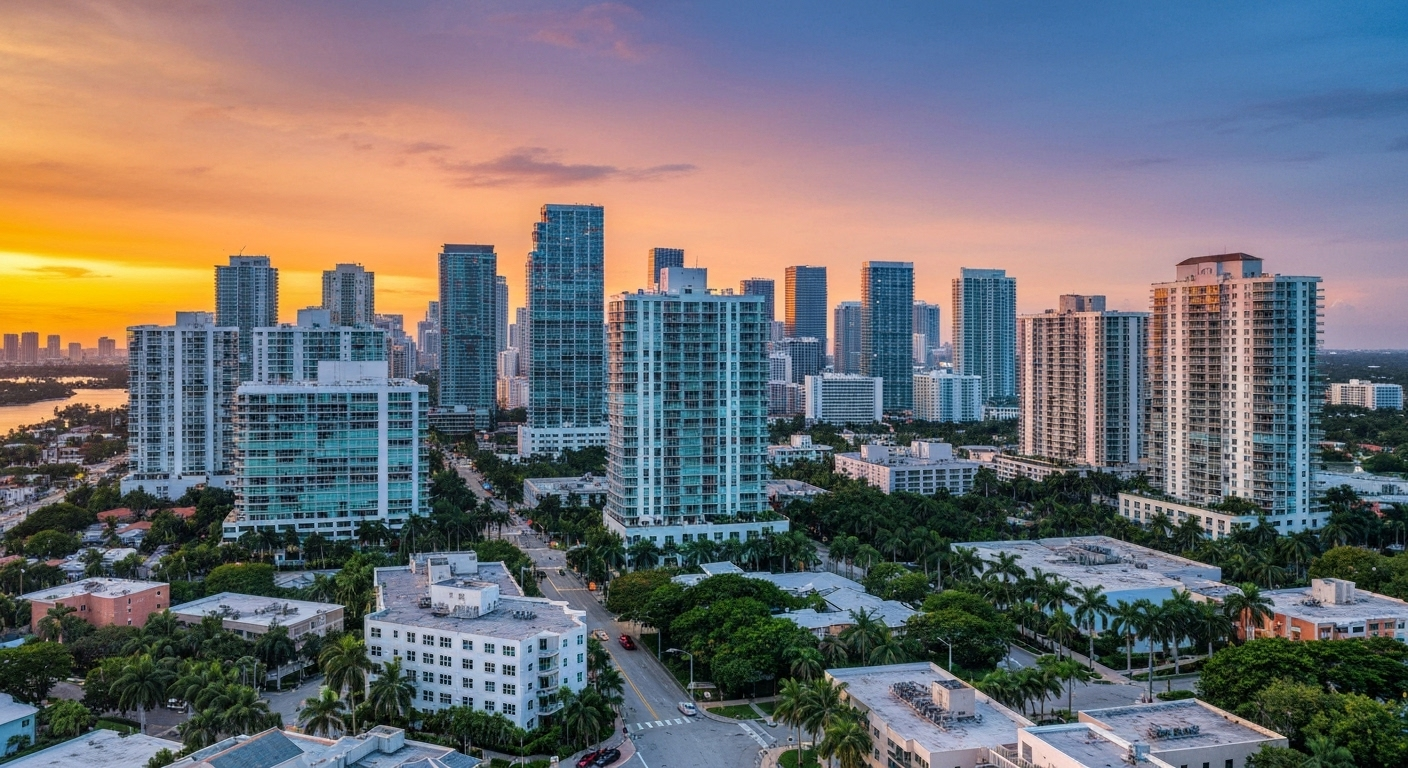Key Highlights
Here's a quick look at the Miami real estate market:
- Miami was recently named the #2 housing market in the U.S. for 2025, showing strong demand.
- Home prices have seen incredible long-term growth, with single-family home values up over 180% in the last decade.
- The market is being shaped by migration from high-tax states and strong interest from international buyers.
- Cash is king in Miami, with over 42% of sales being cash transactions, well above the national average.
- While the market is stabilizing after a period of rapid growth, a major crash appears unlikely.
Introduction
The Miami real estate market is consistently making headlines. With impressive market growth and a reputation as an attractive destination for buyers worldwide, it's a hot topic for investors and homebuyers alike. But with soaring home prices and rapid expansion, questions about a potential housing bubble are natural. Is the market's incredible momentum sustainable, or are there underlying risks you should be aware of? Let's explore the current state of the Miami housing market to understand what’s really happening.
Key Trends Shaping the Miami Real Estate Market

Several powerful forces are defining the Miami real estate landscape. Significant population growth, fueled by both domestic and international movers, has created sustained demand for properties across the city. This influx of new residents has dramatically influenced market trends and the types of homes in high demand.
The appeal of luxury living and a favorable financial environment are also key drivers. These factors have attracted a wave of affluent buyers and investors, reshaping buyer demographics and pushing the market in new directions. We'll look closer at the migration patterns, the role of high-end properties, and the impact of investment.
Shifts in Buyer Demographics and Migration Patterns
A major trend fueling Miami's population growth is the significant domestic migration from other states. People are moving in large numbers from high-tax areas, drawn by Florida's favorable tax environment and a lower cost of living compared to their previous homes. This shift has brought a new wave of buyers into the market.
This migration pattern is primarily driven by residents from:
- New York
- California
- Illinois
Beyond domestic movers, Miami continues to be a magnet for international buyers, especially from Latin America and Europe. The city's vibrant culture, warm climate, and economic opportunities make it a top choice for those looking to relocate or invest. This blend of domestic and international interest creates a diverse and dynamic pool of potential buyers that keeps demand strong.
The Role of Luxury and Waterfront Properties

The luxury real estate sector is a powerful engine within Miami's market. Demand from high-net-worth individuals for high-end homes, particularly luxury waterfront properties, remains incredibly strong. This segment of the market continues to see growth, even when the broader market faces challenges. Affluent buyers are actively seeking signature residences and penthouses, especially in exclusive areas.
For example, sales for luxury single-family homes priced at $1 million or more saw a 3.1% increase compared to last year. This highlights the resilience of the luxury market. Neighborhoods like Miami Beach are epicenters for these transactions, where buyers are looking for premium lifestyle amenities like private yacht docks and stunning views.
This constant demand for upscale properties contributes to the perception of Miami as a high-risk market, as prices in this segment can escalate quickly. However, it also solidifies the city's status as a premier global destination for luxury living.
Influence of International and Domestic Investment
Investment from both abroad and within the U.S. is a cornerstone of Miami's real estate strength. The domestic migration from states like New York and California brings a steady stream of buyers looking to take advantage of the favorable tax environment. These individuals often arrive with significant equity, ready to invest in the local market.
Simultaneously, Miami’s appeal to international buyers, particularly from Latin America, remains as strong as ever. These investors see Miami as a stable place to park their capital and a land of attractive investment opportunities. A clear sign of this is the high number of all-cash transactions in the city.
Over 42% of all home sales in January were cash deals, far exceeding the national average of 29%. In the condo market, that figure jumps to over 50%. This heavy reliance on cash highlights the continued interest from investors who are less affected by fluctuating interest rates and are drawn to the city's vibrant economic landscape.
Miami Home Prices and Sales Activity in 2024
After years of rapid acceleration, Miami's home prices and sales activity are showing signs of stabilization in 2024. The market is transitioning into a more balanced period, moving away from the frenzy of previous years. While demand remains robust, particularly in the luxury sector, the overall pace is moderating.
This cooling trend is visible in both single-family homes and condo sales, though each segment is behaving differently. As inventory levels improve, buyers have more options, which is impacting price growth and sales activity. Let's examine the recent changes in home values, the differences between property types, and the most active neighborhoods.
Recent Changes in Home Values and Price Growth
When looking at the long-term picture, Miami's home values have shown remarkable appreciation. However, the most recent market trends indicate a shift. Following a period of intense price growth, the median home price in Miami has seen a slight correction, with some data showing a nearly 10% drop in median list prices from the peaks of 2024.
This stabilization is a natural response to the market's rapid expansion. For perspective on the incredible growth over the last decade, consider the following data.
- Single-Family Homes – Long-term price growth: Up over 180% in the past 10 years
- Condos – Long-term price growth: More than doubled since 2015
This long-term appreciation is a strong indicator of the market's underlying health. While short-term adjustments are occurring, the value gained over the previous years has provided significant equity for homeowners, with nearly 64% of homes in Miami-Dade classified as "equity-rich."
Differences Between Condo Sales and Single-Family Homes
The markets for single-family homes and condo sales in Miami are currently following slightly different paths. For single-family homes, inventory has seen a significant boost, with active listings up by approximately 24% year-over-year. This increase in new listings gives buyers more choices and negotiating power. Despite this, the luxury tier of this market continues to thrive.
On the other hand, the condo market remains heavily influenced by investors and cash buyers. More than half of all condo transactions were paid for in cash, signaling strong interest from those less dependent on traditional financing. However, there has been a slight dip in this trend, with a 3% decline in cash sales for condos year-over-year.
This suggests that while condos are still a popular investment, rising interest rates and economic uncertainty may be starting to have a minor impact. The distinction between these two segments is crucial for understanding the overall health and direction of Miami's housing market.
Neighborhoods with the Most Real Estate Activity

Real estate activity in Miami is heavily concentrated in several high-demand neighborhoods known for their luxury appeal and prime locations. Waterfront properties and homes on large lots are particularly sought after, driving momentum in these key areas. Buyers are flocking to communities that offer a blend of exclusivity, amenities, and lifestyle.
According to real estate professionals, some of the neighborhoods experiencing the most activity from high-end buyers include:
- Coral Gables
- Coconut Grove
- Miami Beach and its barrier islands
- Pinecrest
Areas like Edgewater and Brickell are also hotspots, especially for those interested in high-rise living and proximity to the urban core. This consistent appreciation in sought-after areas demonstrates that while the broader market may be stabilizing, demand for properties in Miami’s premier neighborhoods remains as strong as ever.
Assessing Miami’s Housing Bubble Risk and Future Outlook
With such rapid price growth in previous years, it's fair to ask about a potential housing bubble. While the market is certainly cooling, experts believe a full-blown crash is unlikely. Instead, the Miami real estate market is entering a phase of stabilization, where prices level off and inventory increases.
However, there are undeniable market risks to consider, from rising insurance costs to the impact of higher interest rates. Understanding the factors that contribute to market vulnerability, alongside expert predictions, is key to navigating the future of Miami real estate. Let's look at what could create challenges and what the experts foresee for 2025.
Factors Contributing to Housing Market Vulnerability
Several factors make the Miami housing market more vulnerable than other cities. One of the most significant challenges is the rising cost of homeowners insurance. These increasing insurance premiums are a direct result of growing climate risks, including hurricanes and flooding, which add a layer of financial complexity for homeowners.
Other factors that contribute to the market's vulnerability include:
- Higher Interest Rates: Increased borrowing costs can dampen demand, particularly among first-time and middle-income buyers who rely on financing.
- Rising Inventory Levels: While great for buyers, a surplus of homes on the market can put downward pressure on prices.
- Affordability Issues: After years of price hikes, homes may become out of reach for those with local incomes.
These elements create a delicate balance. While demand from cash-heavy and luxury buyers provides a strong foundation, these vulnerabilities can affect the broader market and must be monitored closely by anyone considering buying or selling in Miami.
Expert Predictions for 2025 and Long-Term Market Risks
Looking ahead, most real estate professionals offer a cautiously optimistic market outlook for Miami. The consensus is that after a period of rapid price increases, the market will stabilize with moderate growth for the rest of the year and into 2025. A severe crash is not widely predicted.
The MIAMI Association of Realtors, for instance, has highlighted Miami as a top U.S. housing market for 2025, pointing to continued demand. Similarly, the National Association of Realtors (NAR) projects a positive forecast for 2025 and 2026, with expectations of higher home sales and moderating mortgage rates. This suggests a return to a more sustainable pace of market growth.
However, long-term risks remain, including the aforementioned insurance costs and the potential for a decline in broader economic growth. While the frenzy of previous years is over, experts believe the market is simply correcting, not collapsing, and that high-demand areas will continue to see consistent appreciation.
Conclusion
In summary, understanding the Miami real estate market is crucial for both buyers and investors alike, especially in light of the current housing bubble risks. Key trends such as shifting demographics, the influence of luxury properties, and varying sales activity across neighborhoods provide valuable insights into market dynamics. By staying informed about price fluctuations and expert predictions, you can make smarter decisions in this ever-changing landscape. Whether you're considering buying a home or investing in property, knowledge is your best ally. If you're ready to dive deeper or need personalized advice, don’t hesitate to schedule a free consultation with us!





